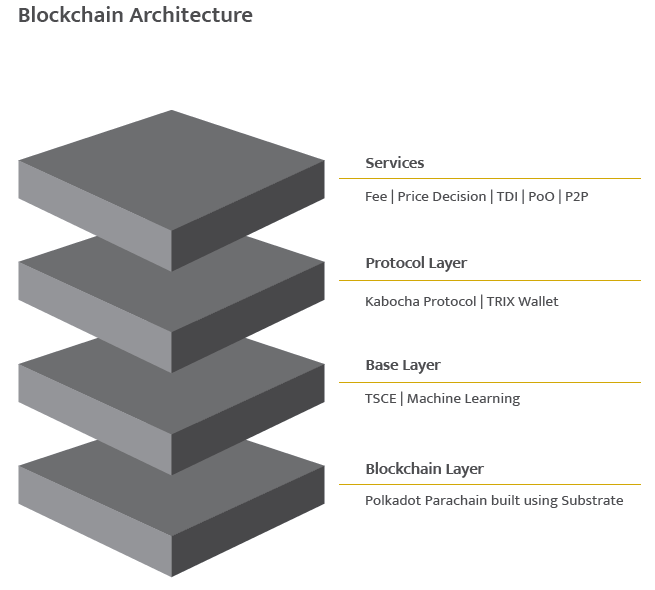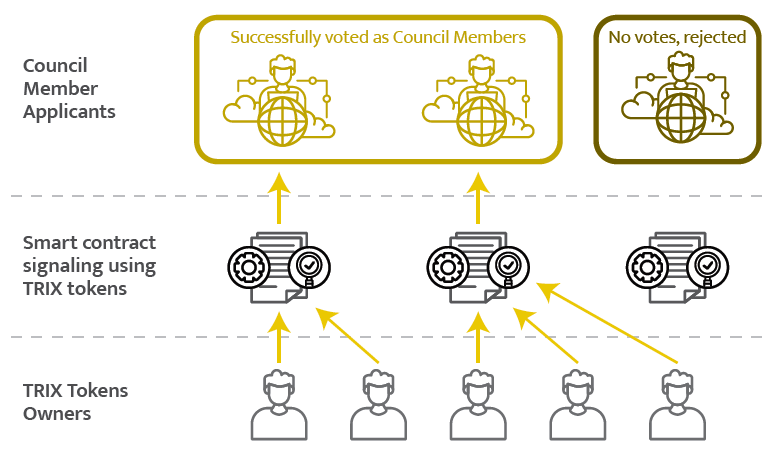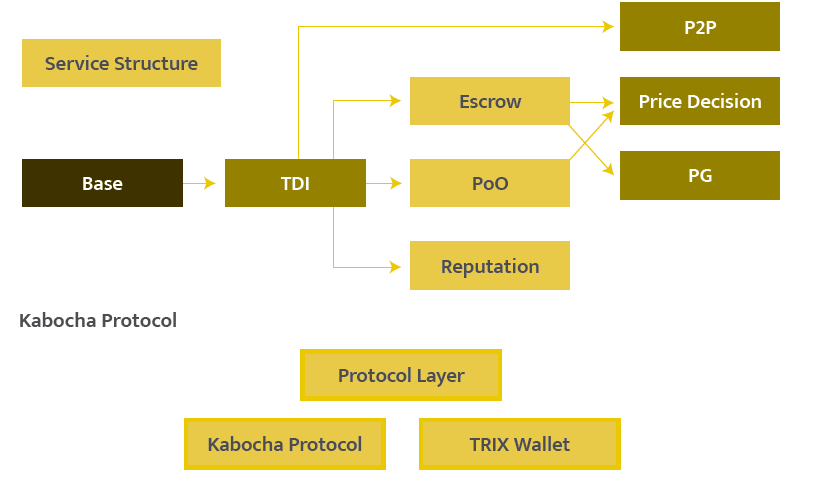Introduction to TriumphX (TRIX) part 3: The Blockchain architecture powering our decentralised, in-game item exchange
Vision
TriumphX is a decentralised exchange optimised for in-game item trading. These in-game items exist in the exchange as non-fungible tokens (NFT). Our goal is to create a highly liquid decentralised market that enables users to trade NFTs across major blockchain platforms.
To achieve this, TriumphX will integrate with other markets including decentralised exchanges to create a deep pool of NFT assets for trading liquidity. Next, the TRIX token will be used to create a sustainable token economy on the TriumphX ecosystem through game theory and tokenomics structure. With gamers in mind, the TriumphX ecosystem is designed to complement the growth and demands of the gaming and Esports industry.
The backbone of our ecosystem is reflected in the TriumphX blockchain technology:
TriumphX blockchain technology
TriumphX blockchain technology comprises of 3 layers and an increasing number of services to complement general DApp development.

1) Blockchain Layer
The TriumphX team wanted to create a blockchain that can excel in these 4 primary areas: transparency, stability, security, and scalability. To achieve this, TriumphX will be built on the Polkadot network as a parachain.
Polkadot enables interoperability and scalability by allowing specialized blockchains to communicate with each other in a secure, trust-free environment. Through the parallelized model of Polkadot, the TriumphX parachain can be compile into WebAssembly(WASM) and be connected to the Polkadot network.
Although the Polkadot Relay Chain does not implement smart contracts natively, it is possible for parachains to enable smart contract functionality and benefit from the security and interoperability features of Polkadot.
In addition, the TriumphX parachain will have the ability to contain our own runtime logic while at the same time, benefit from Polkadot Relay Chain’s shared security and cross-chain messaging. With this high degree of flexibility and customization, TriumphX will be able to customize the chain according to the commercial needs of partners within the network.
TriumphX will be developed using Substrate Core, which grants us the ability to design the entire runtime and implement it from scratch.
i. TriumphX Council Reward System
Stability is a major consideration for the TriumphX ecosystem. To achieve a high level of stability and availability, validators need to be reliable and trustworthy to conduct successful node operations.
To reward honest validators to join the network, TriumphX will introduce a Council Reward System. At the initial stages of the blockchain development, we foresee that blockchain activity will be lower and independent validators may not be able to cover their running cost purely on fees. To resolve this issue, TriumphX will be recruiting multiple trusted council members to secure the network nodes. The triumph team target to make the recruitment process to be as decentralised and independent as possible.
The initial council members will receive a 5% return on staked tokens. Such compensation plans will remain effective until 101 companies are registered as validators.
The council members also act as a form of governance for the TriumphX blockchain and will have the ability to vote on key decisions concerning the TriumphX blockchain such as platform fees.
ii. Creating a Sustainable Decentralised Governance Model
As we expect centralized exchanges to hold significant sums of tokens, safeguards will be put in place to ensure that exchanges are barred from the governance process and voting process. This is to prevent manipulation of the network in the interest of the exchanges using tokens which are not owned by themselves. These safeguards include identification on the blockchain and active governance from the validators to bar addresses that have been identified as exchange addresses on the network.
The blockchain is envisioned to start with 2 validators, each managed by the TriumphX team. As the ecosystem grows, the number of validation slots will increase up to the point of 101 validators. Beyond the 101 validators, any validation slots increase will be decided by the blockchain governance of that time.
Each validator term lasts for a period of 12 months. After the initial 12-month period, all validators, including the initial 2 seats controlled by the founders, will be put up for voting by the network users. This ensures true decentralization of the network.
In the long-term, TriumphX is able to fulfil the creation of Decentralised autonomous organisations (DAOs) in the blockchain ecosystem. This allows projects greater coordination and flexibility outside of the initial validator setup. These DAOs can be governed by various decision-making processes such as simple 1-person-1-vote mechanism, delegated voting, 1-token-1-vote, or other more complex mechanisms.
iii. Election of Validators
Users can vote for validators by time-locking their TRIX tokens to vote for certain decisions on governance of the TriumphX blockchain. These tokens will not be spent and will be returned to the voters after a certain period of time.

2) Base layer
The base layer performs the basic blockchain functionality of the network. Its roles include connecting the blockchain to the external, real-world services and maintaining mainnet stability. It is also responsible for the configuration of blockchain components.
i. TSCE (TriumphX Smart Contract Extension)
To service external, real-world contracts, TriumphX uses extended functions to enable smart contracts on the blockchain. TriumphX provides TSCE (TriumphX Smart Contract Extension), which adds TriumphX’s own extension to the existing Substrate API.
Real-life contracts require a variety of information, such as the coin price of exchanges, stock price, exchange rate, weather information, and even a random number generator used in games or lotteries. When retrieving data from outside the blockchain, it is necessary to validate/ factcheck the information and be able to adjust accordingly. The TriumphX blockchain uses the TSCE to implement Oracle functions in a decentralized way to make this happen.
TSCE, performing the role of an Oracle, can allow schedule execution of a function or smart contract in a decentralised manner. In the longer term, TSCE plans to create a library of functions with scalability in mind. One key focus will be hacking prevention using blockchain technology.
ii. Machine Learning
While designing the TriumphX platform, one of our focus is to research synergies between blockchain and machine learning techniques. We believe that these 2 emerging technologies have common grounds in data analytics and security. For example, machine learning can play important roles in the TriumphX ecosystem, such as anomaly detection to spot external attacks, and pricing system to quickly determine the appropriate fee and price. Our research is ongoing and will be incorporated in the products and services we offer.
3) Protocol Layer
The TriumphX platform provides decentralized protocol called ‘Kabocha’ that can be easily extended and connected to enable effortless creation of decentralized applications (DApps). This protocol is managed by TSCE and API. The TriumphX platform manages the dependency of API libraries and provides a convenient development environment.
As the Kabocha protocol is designed as an open platform, anyone can connect to TriumphX. Documentation and tutorials for the Kabocha Protocol and all APIs will be released on GitHub in line with the testnet release schedule.

i. TRIX Wallet
For security purposes, a dedicated wallet is required to perform TriumphX Digital Identity (TDI) or mutual evaluation information on the TriumphX platform. While the wallet itself is not a blockchain-based component, it is necessary for the TriumphX platform to provide an integrated service. Wallets needed to be protected with the highest level of security in the decentralized blockchain technology. The source code of the wallet will be released as an open source and will be continuously audited for security issues.
4) Services
The services provided by TriumphX are optimized for general DApp development. Services will be constantly updated and added. The current services include: 1) Fee Service, 2) Escrow Service, 3) TriumphX Digital Identity (TDI) Service, 4) Proof-of-Ownership (PoO) Service, 5) P2P Transaction Decision Service and 6) Pricing Service. This will be discussed in greater detail in our next deep dive article.
All in all, TriumphX aims to provide a decentralised exchange to conduct peer-to-peer (P2P) trading without the need for hefty fees and to lose control of their digital in-game assets.
TriumphX was designed and built by gamers, for gamers.
**********************************
Follow our social media channels to keep up to date on our developments!
Twitter: https://twitter.com/TrixTriumphX
Telegram: https://t.me/TRIXcommunityEN
Website: http://trix.deeple.io/
Introduction to TriumphX (TRIX) part 3: The Blockchain architecture powering our decentralised… was originally published in TriumphX on Medium, where people are continuing the conversation by highlighting and responding to this story.


